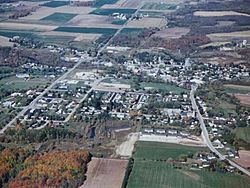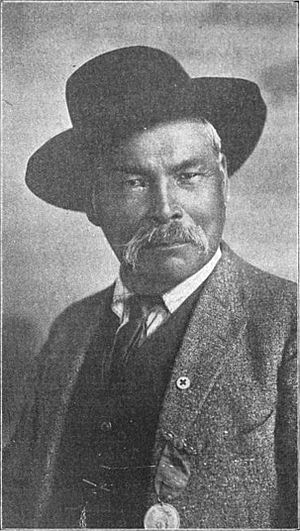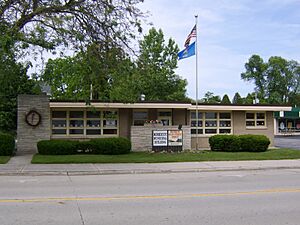Mishicot, Wisconsin facts for kids
Quick facts for kids
Mishicot, Wisconsin
|
|
|---|---|

Mishicot from the air
|
|

Location of Mishicot in Manitowoc County, Wisconsin
|
|
| Country | |
| State | |
| County | Manitowoc |
| Established | 1847 |
| Area | |
| • Total | 2.60 sq mi (6.73 km2) |
| • Land | 2.55 sq mi (6.61 km2) |
| • Water | 0.05 sq mi (0.13 km2) |
| Elevation | 627 ft (191 m) |
| Population
(2010)
|
|
| • Total | 1,442 |
| • Estimate
(2019)
|
1,388 |
| • Density | 544.10/sq mi (210.12/km2) |
| Time zone | UTC-6 (Central (CST)) |
| • Summer (DST) | UTC-5 (CDT) |
| ZIP code |
54228
|
| Area code(s) | 920 |
| FIPS code | 55-53350 |
| GNIS feature ID | 1583731 |
Mishicot is a small village located in Manitowoc County, Wisconsin, in the United States. In 2010, about 1,442 people lived here. It's right next to the larger area known as the Town of Mishicot.
Contents
The History of Mishicot Village
Early Native American Communities
Long ago, the land where Mishicot now stands was home to Native American tribes. These included the Menominee, Potawatomi, and Ho-Chunk peoples. After French rule ended in 1763, many Potawatomi moved towards the Detroit area.
Later, some Potawatomi returned to northern Wisconsin. Others moved further south to Indiana and Illinois.
Land Treaties and Settlers
In 1831, the Menominee tribe signed a treaty. This agreement gave their land, including Mishicot, to the United States. This meant new settlers could buy land there. However, many fishermen chose to live as squatters without officially owning the land.
The Potawatomi tribe, who were more spread out, lost their land without being paid. Many of them moved to Canada. They were invited by other Native Americans already living there. They also wanted to avoid the tough rules of the 1833 Treaty of Chicago.
This treaty said that if Potawatomi people didn't move west, they wouldn't get money for their land. Even though not all Potawatomi agreed to this treaty, it was the government's rule.
Simon Kahquados: A Potawatomi Leader
Simon Kahquados was a Potawatomi leader who lived in Mishicot. He worked hard to get the land back for his people. He traveled to Washington, D.C., many times to speak up.
In 1906, a law was passed to count all Potawatomi who used to live in Wisconsin and Michigan. This was the first step towards paying them back. The 1907 "Wooster" roll listed 457 Potawatomi in Wisconsin and Michigan. It also listed 1,423 in Ontario, Canada.
Instead of getting their land back, they received a small monthly payment. Even though Kahquados didn't get the land returned, he helped people learn more about Potawatomi history. In 1931, 15,000 people came to his burial in Peninsula State Park.
How Mishicot Got Its Name
The village was first spelled "Mishicott," with two 'T's. It was named after a Potawatomi Chief called Mishicott. His Potawatomi name was Na-ya-to-shingh, which means "Hairy Leg." This name came from the fluffy white feathers on the upper leg of a horned owl.
Around 1950, the second 'T' was officially removed. This happened when the village became a legally recognized place in Wisconsin.
Early Settlers and Growth
The first settlers in Mishicot and the farms around it came from many countries. Most of them were from Germany, Bohemia, Switzerland, and Canada. In 1852, the village and township were briefly renamed Saxonburg. But about 18 months later, the name went back to Mishicot.
By the early 1900s, Mishicot was a busy place. It had six hotels, three general stores, and a movie theater. There was also a grist mill (for grinding grain), a brewery, and three churches. The first public school was started in 1849, and its building was built that same year.
Geography of Mishicot
Mishicot is located at 44°14′6″N 87°38′29″W / 44.23500°N 87.64139°W.
The village covers about 2.57 square miles (6.66 square kilometers). Most of this area is land, with a small part being water. The East Twin River flows right through the village.
Mishicot is located roughly halfway between I-43 and WIS 42. You can reach the interstate and the city of Two Rivers using WIS 147.
Mishicot's Population and People
| Historical population | |||
|---|---|---|---|
| Census | Pop. | %± | |
| 1880 | 159 | — | |
| 1960 | 762 | — | |
| 1970 | 938 | 23.1% | |
| 1980 | 1,503 | 60.2% | |
| 1990 | 1,296 | −13.8% | |
| 2000 | 1,422 | 9.7% | |
| 2010 | 1,442 | 1.4% | |
| 2019 (est.) | 1,388 | −3.7% | |
| U.S. Decennial Census | |||
What the 2010 Census Showed
In 2010, the census counted 1,442 people living in Mishicot. There were 623 households and 419 families. The village had about 572 people per square mile (221 people per square kilometer).
Most of the people living in Mishicot were White (97.5%). There were also small numbers of African American, Native American, and Asian residents. About 0.9% of the population identified as Hispanic or Latino.
About 29.7% of households had children under 18. Most households (54.3%) were married couples living together. About 28.1% of households were individuals living alone. Of these, 13.5% were people aged 65 or older.
The average age in Mishicot was 44.3 years. About 21.5% of residents were under 18. The population was almost evenly split between males (49.4%) and females (50.6%).
Education in Mishicot
The Mishicot School District serves the village and nearby towns. It includes three schools:
- O. H. Schultz Elementary School
- Mishicot Middle School
- Mishicot Community High School
All these schools are located in the northeastern part of the village. The middle and high schools are connected buildings.
Famous People from Mishicot
Some notable people have come from Mishicot:
- Cindy Bremser: A retired long-distance runner who competed in the 1984 U.S. Olympics.
- Vicki Goetze: An LPGA golfer who won U.S. Amateur and NCAA championships. She was also named American Junior Golf Association Player of the Year in 1988 and 1990.
- Edgar A. Jonas: A U.S. Representative from Illinois from 1949 to 1955.
- Joseph Rankin: A U.S. Representative from Wisconsin from 1883 to 1886.
- Christian Sarau: Served as a Wisconsin State Representative in 1899 and a State Senator from 1903 to 1904.
- Raymond J. Scheuer: A Wisconsin State Representative in 1933.
- Nicholas H. Terens: Served in the Wisconsin State Assembly in 1903.
See also
 In Spanish: Mishicot (Wisconsin) para niños
In Spanish: Mishicot (Wisconsin) para niños



